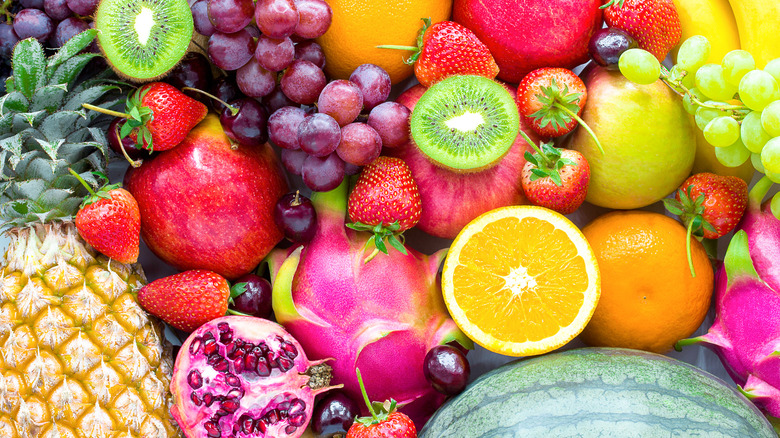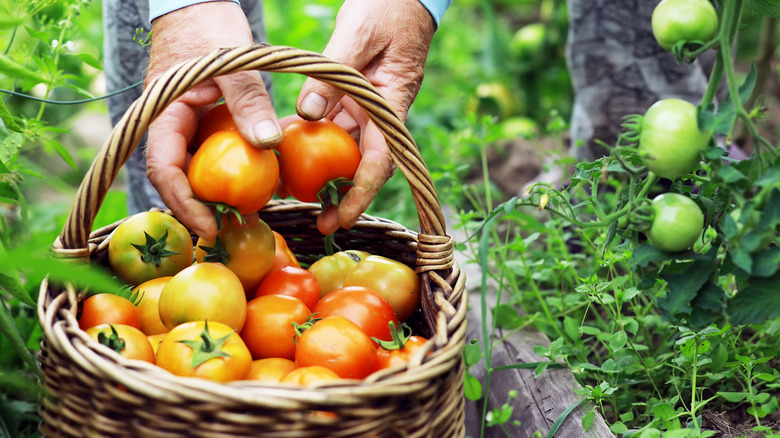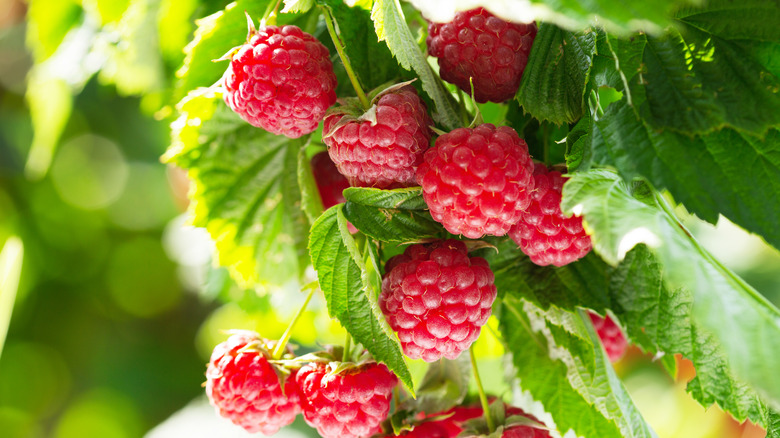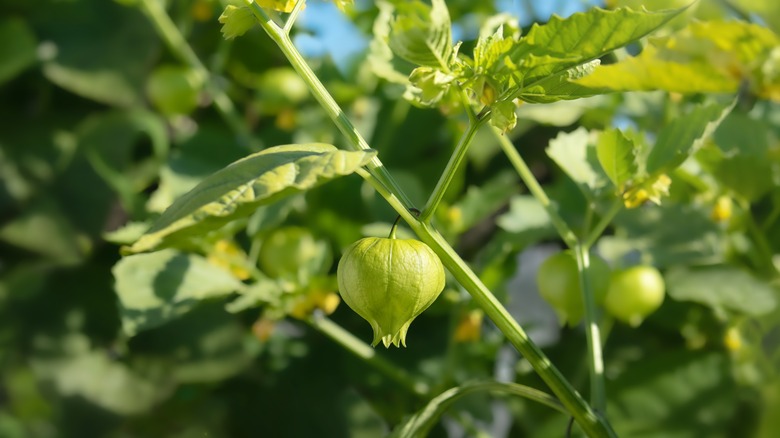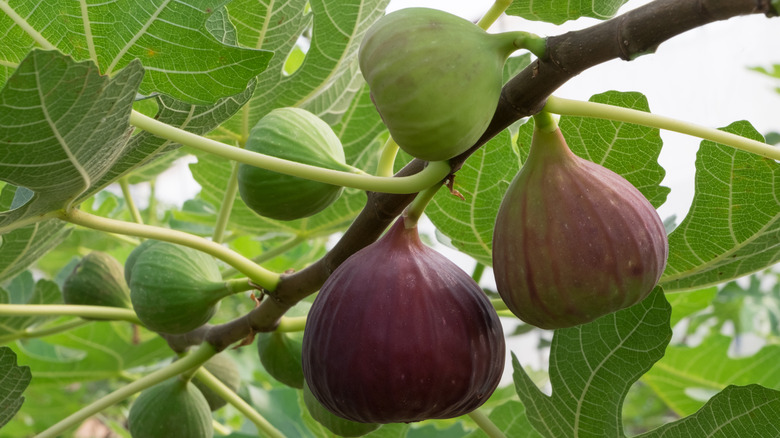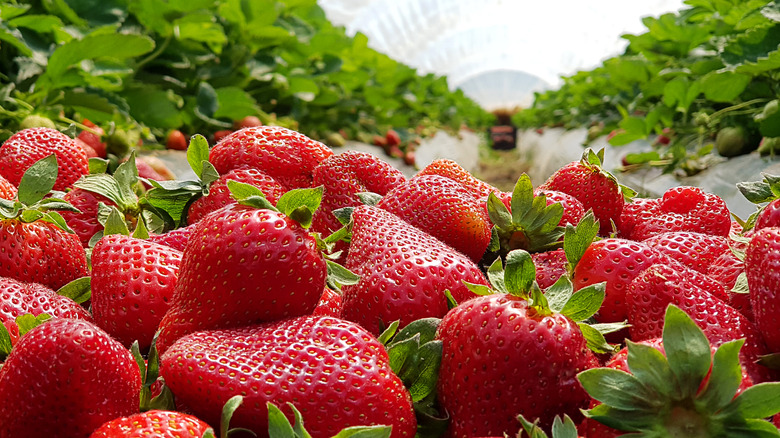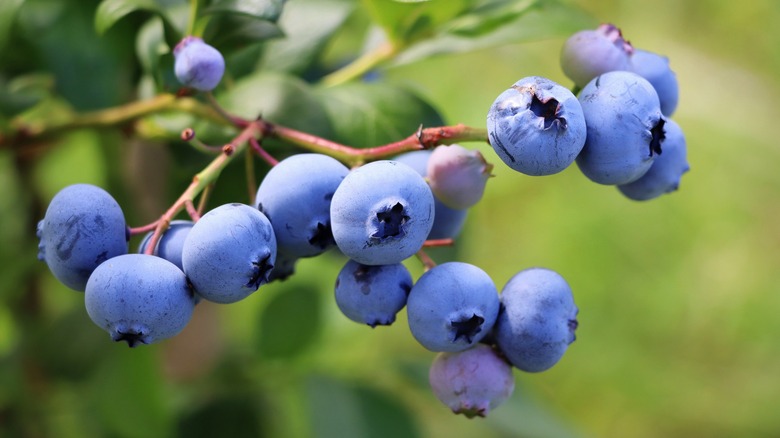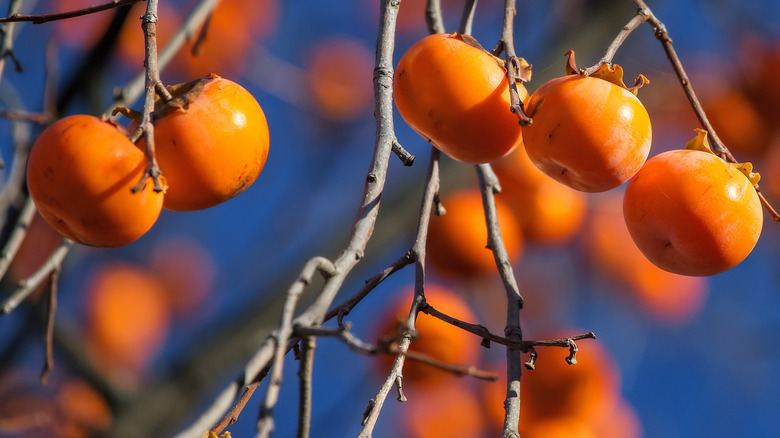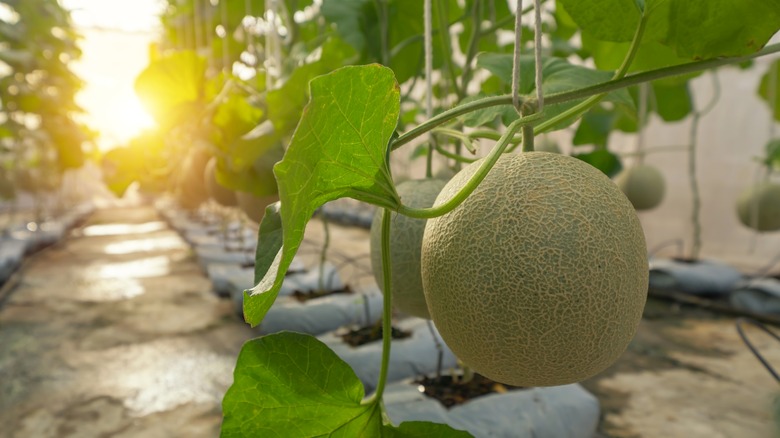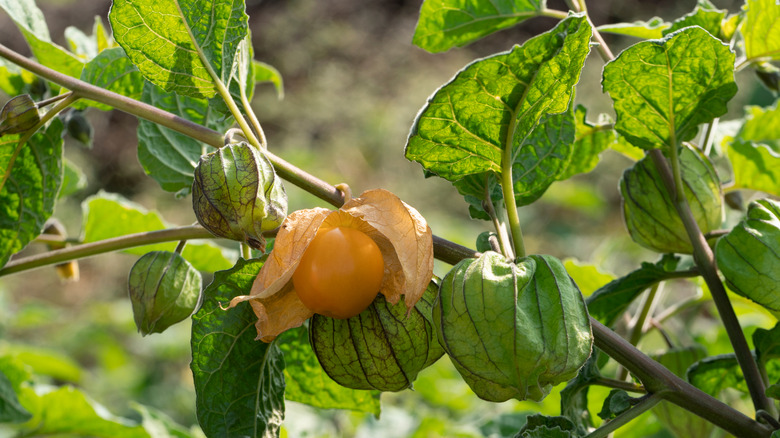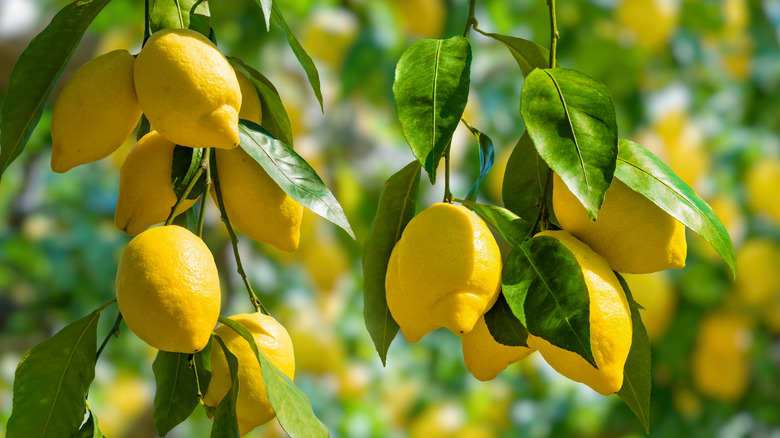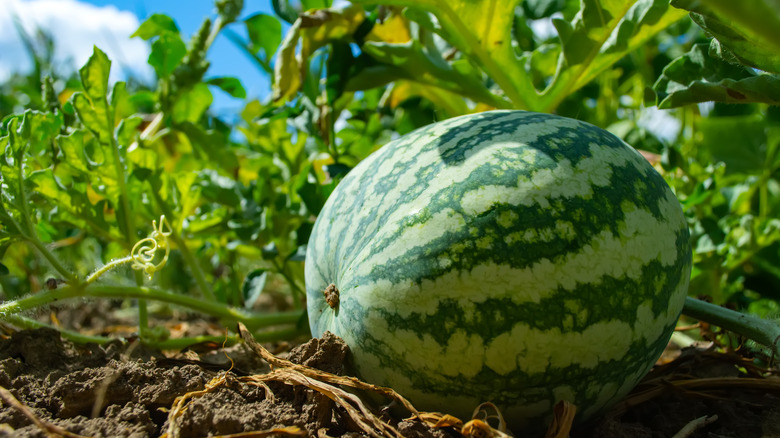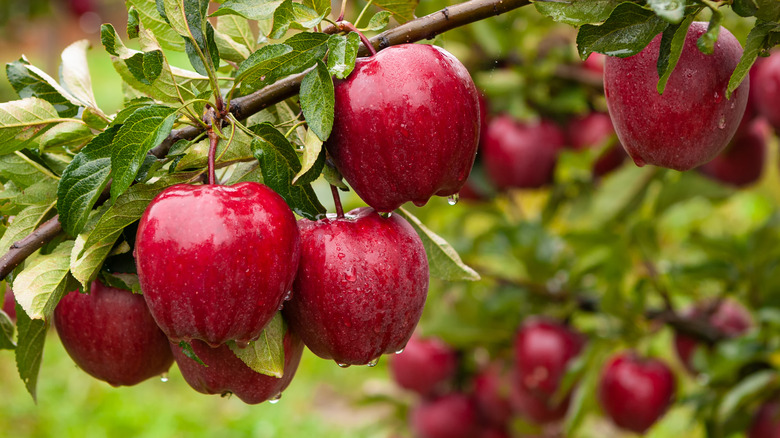The Best Fruits To Grow If You've Never Gardened Before
Anyone who frequents their local farmers' market may be quick to point out that fresh, homegrown fruits taste extra delicious. However, starting your own home garden can seem like a daunting prospect. It requires buying a number of necessary tools — from gloves to spades to fertilizer — and learning gardening tips like when it is best to plant and how often you'll need to water.
Luckily, growing your own produce isn't rocket science, just botany. After all, humans have been doing it for ages. According to National Geographic, ancient Syrians started growing fruits more than 11,000 years ago. Home gardens took off in popularity in Western countries around WWII, Encyclopedia Britannica notes.
Even if you are gardening for the first time, there are plenty of fruit plants that are easy to grow in your yard or even in a container garden on a balcony or porch. With many affordable fruit seed packets on the market, what's there to lose?
Tomatoes
You could say the category-bending tomato is both a fruit and a vegetable. Botanically, tomatoes are a fruit, Healthline points out, because they grow from flowers and contain a multitude of seeds. In culinary practice, however, they are classified as a vegetable because of their savory applications.
Whether you're team fruit or team vegetable, there's no denying that summer tomatoes are one of the most prized bounties of a home gardener. They're not only easy to grow, but they also are a versatile ingredient in the kitchen. The main thing you'll need to successfully grow tomatoes is a lot of sun, The Spruce notes. The plant performs best in strong, direct sunlight and also requires warm weather, so it's best to wait until summer is in full swing to put tomato seedlings into the ground. According to Home Depot, tomato plants need the temperature to be consistently over 60 degrees Fahrenheit. Once you've planted your tomatoes, make sure they get a lot of water consistently, otherwise, they'll start cracking and splitting.
If you want to increase your tomato plants' odds of success, look to their typical culinary friends: basil, onions, and garlic (per Home Depot). Not only do these ingredients complement tomatoes in a number of recipes, but when grown together, they also help the plants repel certain pests.
Raspberries
Growing raspberries used to take a little more time and space, but new generations of the seed are now easy to grow even in container gardens on balconies (via Garden Tech). This includes compact varieties like Raspberry Shortcake that grow to be only 3 to 4 feet tall, but pack as much flavor as normal-sized plants. If you want to grow a full berry patch of a larger raspberry variety, you're going to need enough room to house a trellis system and to properly space rows of the plants.
If you've decided to attempt raspberries, it's best to plant them after the threat of frost has passed, Garden Tech notes. They'll need full sun and soil that is slightly acidic and rich in organic matter.
One advantage of growing raspberries is that they are perennial, meaning that they come back year after year if they are taken care of properly, Garden Tech explains. Some raspberry plants have been known to last for a decade or more. However, the crowns where the actual berries grow only last a year, so it is essential to prune plants each season to ensure the next season's harvest is a success.
Keep in mind that you will likely have to freeze your harvest, since the berries are delicate and don't stay good for long once they are picked.
Tomatillos
If you're a lover of Mexican food, tomatillos will be the perfect addition to your home garden. The fruit, which grows in husks, has the appearance of unripe green tomatoes but tastes less sweet and more acidic than their distant cousins. You can do a lot with your summer tomatillo bounty — from using them raw as an acidic ingredient to brighten up a dish or roasting them to make your own salsa verde.
Plant at least 2 tomatillo plants (to better ensure pollination) once the threat of frost passes in your area, Bonnie Plants explains. Not sure when that will be? Check out The Old Farmers' Almanac's handy calendar to figure out your area's date. Growing at least 2 tomatillo plants will help you out with your planned recipes as well. Most plants bear around 1 pound of fruit, Bonnie Plants notes, while most recipes require around half a pound of tomatillos. If you want to eat plenty of chips and (homemade) salsa this summer, plan ahead.
Tomatillos require a lot of the same gardening tips as tomatoes, Bonnie Plants point out. When planting them, you'll need to bury about two-thirds of your transplant. They'll also need a trellis for support and a lot of sun.
Figs
Figs are one of the OGs of the culinary world. Adam and Eve reportedly wore fig leaves to cover themselves in the Garden of Eden, and the New York Times points out that they were the first fruit cultivated by humans. While fig trees are typically associated with the Mediterranean or more temperate climates, they also can be grown in cooler regions, The Old Farmer's Almanac says. However, it's always best to bring trees in containers indoors if it gets too cold.
If you'd like to take a more typical route of planting a fig tree in your garden, you'll need to live in an area with a long, hot summer, which The Old Farmer's Almanac defines as Zone 8 or higher. When choosing a fig species to grow, keep in mind that some do not bear edible fruit. The typical choice for most home gardeners is the common fig tree because this plant does not require pollination to bear fruit.
The best time to plant your fig tree is late spring/early summer. Figs grown in pots will need a little extra care — in the form of fertilized soil — but in-garden plants can successfully grow in most soil types (via The Old Farmer's Almanac). All varieties require deep watering once a week and a healthy amount of sun. Once your tree has successfully produced figs (congrats!), make sure the fruit is actually ripe before you harvest it. Figs are notorious for not ripening off the branch.
Strawberries
Strawberries are No. 1 on the Environmental Working Group's Dirty Dozen list of produce that contains the most pesticides, so opting to grow them at home instead is a healthy choice. Strawberries grow from a low-to-the-ground bush that self pollinates throughout the growing season, Garden Tech points out.
There are 3 main types of strawberries that home gardeners should consider. June-bearing strawberries blossom in late spring and normally stop producing fruit after that until the following year (via Garden Tech). Day-neutral strawberries are hardier than other strawberry plants and can handle more variation in temperature, therefore producing berries throughout a longer harvesting season. Everbearing strawberries have a spring crop and a fall crop.
Home gardeners just starting out can buy strawberry plants to transplant into the garden in spring instead of growing them from seed. They'll need 6-8 hours of sunlight a day and a weed-free growing site, otherwise, the weeds will compete with your berries for resources. While the berry is easy to grow, you'll have to contend with some rodents and pests that would also like to savor your delicious bounty. Protective netting can be a solution here, DIY & Crafts says. However, make sure not to use this while the plants are still flowering, as it can prevent pollination.
Blueberries
With the small size of their fruit, blueberries are another plant that is perfect for home gardeners because they can be grown in containers. However, one thing blueberries are picky about is their soil. The plants need an acidic pH to thrive, so opting for container gardens or raised beds can also help you better control the growing environment (via US Highbush Blueberry Council).
Not sure what the pH of your soil is? A home test can help you out with that, Joe Gardner notes. If the soil isn't acidic enough, an easy fix is adding some sulfur to it when planting. Pelletized sulfur is the best bet for a home gardener, as it's safer to use and much less expensive.
Whether you're growing them in containers or creating a patch in your yard, blueberries will need plenty of sun, water, and well-drained soil, notes the US Highbush Blueberry Council. The plants should be spaced 2 feet apart if you'd like them to grow in rows, or 6 feet apart if you're growing individual plants.
To keep your blueberries happy all season, don't forget to prune, Joe Garner points out. This will ensure the berry bushes can come back year after year. If taken care of properly, this perennial can last up to 50 years, so you'll have plenty of blueberry muffins in your future (via University of Maine).
Persimmons
Persimmon trees aren't just a great addition to a home garden because of their delicious fruit. They're also attractive trees in their own right — notable for their gorgeous fall foliage that features bright red, orange, and gold leaves (via Gardening Tips). If you're hesitant to plant a fruit tree, don't be. They're actually not a lot more work than other plants, HGTV points out.
There are a few different varieties of persimmon trees for you to consider depending on where you live. The American persimmon tree is best if you're in the Midwest or colder parts of the East Coast, and the Japanese varieties are better suited for temperate coastal climates (per HGTV).
Your best bet is to buy a tree from a nursery instead of trying to plant one from seed yourself, which can be more of a finicky process. As fruit expert Ed Laivo tells HGTV, persimmon trees are "very easy to take care of" once you're purchased a healthy tree for transplant. They have few pests and are adaptable to most soil types.
The main downside of these beautiful plants is that they can be quite expensive. However, once you've committed to raising persimmons, you'll enjoy a bounty of delicious fruit. May we suggest a nice persimmon jam or a tasty persimmon pudding?
Cantaloupe
While cantaloupe is often what's leftover from the fruit salad bowl, we promise that the fruit can achieve a higher flavor potential. Fresh from the garden cantaloupe is an entirely different experience than the grocery store version of the melon, which tends to be watery and flavorless. If you live in a warmer climate, the melon is an excellent addition to your home garden. It requires 2-3 months of heat, along with lots of sunlight and moisture, Bonnie Plants explains.
These water-loving plants do best if you use drip irrigation or a soaker hose to keep the soil wet. It's also important to know that cantaloupes like to sprawl out, so you'll need to have enough space to plant the melons 3 to 4 feet apart (via Bonnie Plants).
To get the optimum flavor from your 'loupe, let the strongest fruits survive. It's best to cut off smaller melons to let the ones that are thriving really flourish (per Bonnie Plants). All of your cantaloupes are likely to ripen within the same 3-4 weeks. You can tell if the melon is ready to be picked if its color changes from a grayish-green to more of a yellow and the netting on its skin "becomes more pronounced," Bonnie Plants notes.
Ground cherries
If you're not familiar with ground cherries, you're in for a treat. The bright orange-gold fruit grows in husks in the same vein as a tomatillo and has a tart flavor. According to Smithsonian Magazine, the little fruit tastes like a "cherry tomato injected with mango and pineapple juice." Ground cherries can be used in everything from pies to salsa and are a super easy plant to grow for a first-time gardener.
If we've piqued your interest, you can start growing ground cherries from seed indoors 6-8 weeks before the last frost date or opt for a transplant for a simpler solution (per Good Housekeeping). The plant shouldn't be put into the ground until the threat of frost passes. Because ground cherries require a lot of drainage, a raised bed is a good bet.
Afterward, you'll be off to the races! According to Good Housekeeping, each plant produces 300 ground cherries consistently until the end of the growing season. To keep your plants healthy, mulch around the plants to suppress weed growth and give them about 2 inches of water a week.
Lemons
While lemon trees can't be grown in every climate, gardeners in temperate areas should have an easy time with the citrus plant. They thrive in Zones 8-11, which comprises the subtropical "citrus belt" of the US, The Spruce notes.
According to Gardening Know How, these trees are more sensitive to cold than other citrus plants. They all need a good amount of sun and deep watering at least once a week. If you take care of these basic needs, the trees will give it all back to you in the form of delicious lemons.
Lemon plants can be grown indoors or outdoors, Gardening Know How points out. Indoor plants just need to be in a Southern-facing warm and sunny room in your home. They'll only thrive if the temperature doesn't fall below 55 degrees Fahrenheit at night and sticks around 70 degrees Fahrenheit during the day. While lemon trees work as house plants, they're much more likely to produce fruit if they are put outside. This is because insects can't easily pollinate them indoors.
If you want to plant a lemon tree outside, The Spruce suggests digging a hole as wide and as deep as the plant's root ball. You'll need to water them 1-2 times a week while they get situated, but afterward, they'll be more tolerant to drought. You'll have to be patient with lemons as well — sometimes, the fruit takes a full year to ripen enough for harvest after initially growing on the tree.
Watermelon
Watermelon is a staple of any summer picnic, so you'll definitely impress your friends by bringing lemonade this summer made from your homegrown fruit. The trick here is watermelons love the summer heat, so you'll need to live somewhere with a long, hot growing season, Growfully notes. You'll also need plenty of space to let these babies properly sprawl out.
Unlike a lot of other commonly grown plants, watermelon don't like to be disturbed once they've been planted. For this reason, it's a better idea to sow them from seed than to find a transplant, Growfully explains. Plant watermelon a couple of weeks after the last frost date, when soil temp has raised to around 70 degrees Fahrenheit.
After sowing your seeds, expect to wait a solid 80-90 days before your fruit will be ready to harvest. Feeling anxious? Some smaller varieties, like Sugar Baby watermelons, are ready to harvest in closer to 70 days (per Growfully). When choosing what watermelon type is best for your garden, you'll get to select from some pretty fantastic names like Moon and Stars, Orangeglo, and Blacktail Mountain. All offer something a little different, from interesting rind markings to orange/yellow coloring.
Once you've had your fill of fresh slices or lemonade, try out some of our other watermelon-based recipes for a fun summer treat.
Apples
Last but not least, America's favorite apples make an excellent addition to any garden. Apple trees are a multi-season delight. Apart from producing delicious fruit, apple trees' light pink flowers welcome spring and bright orange hues brighten up fall. Fortunately, you don't have to travel all the way to your closest apple orchard to enjoy apple trees. The plant is available as a transplant at many nurseries (per The Old Farmers' Almanac).
According to Gardener's Path, what you need to successfully raise an apple tree is a lot of sunshine and well-drained soil. The plants also require a good amount of space, so if your yard can't exactly fit a 20- to 30-foot tree in it, it's best to opt for a dwarf variety. The 4- to 8-foot trees produce smaller fruit, but they are easier to harvest due to their height. If you do choose a dwarf variety, you'll need to properly secure it or it might get damaged in severe weather.
Apple trees also love company. To best produce fruit, many species of apple trees need to cross-pollinate with another fruiting tree that flowers around a similar time, Gardener's Path says. Luckily, there are a few self-pollinating options if your yard won't accommodate a mini orchard.
